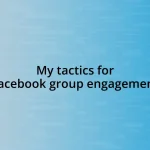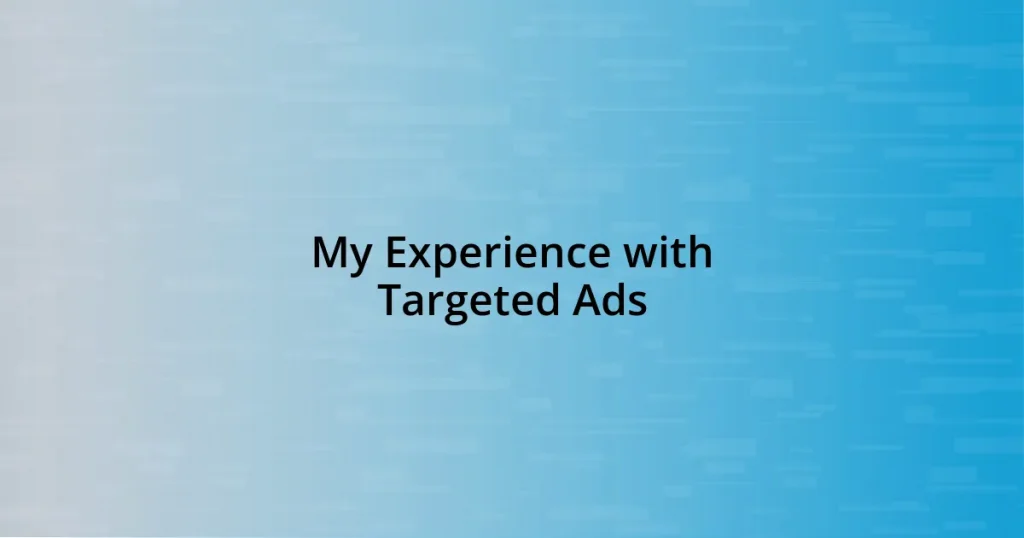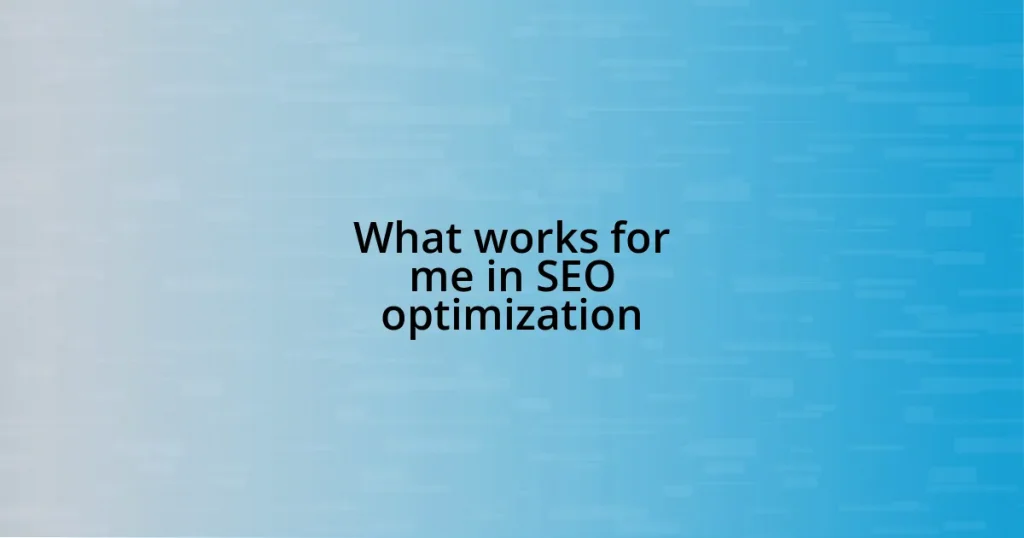Key takeaways:
- Targeted ads leverage algorithms to personalize user experiences, raising concerns about privacy and data tracking.
- Personal experiences with targeted ads evoke mixed feelings of intrigue and discomfort, highlighting the balance between convenience and surveillance.
- Being aware of online behavior and diversifying interests can help manage the overwhelming nature of targeted advertisements.
- Adjusting ad preferences empowers users to take control of their online experience, reducing unwanted marketing pressure.
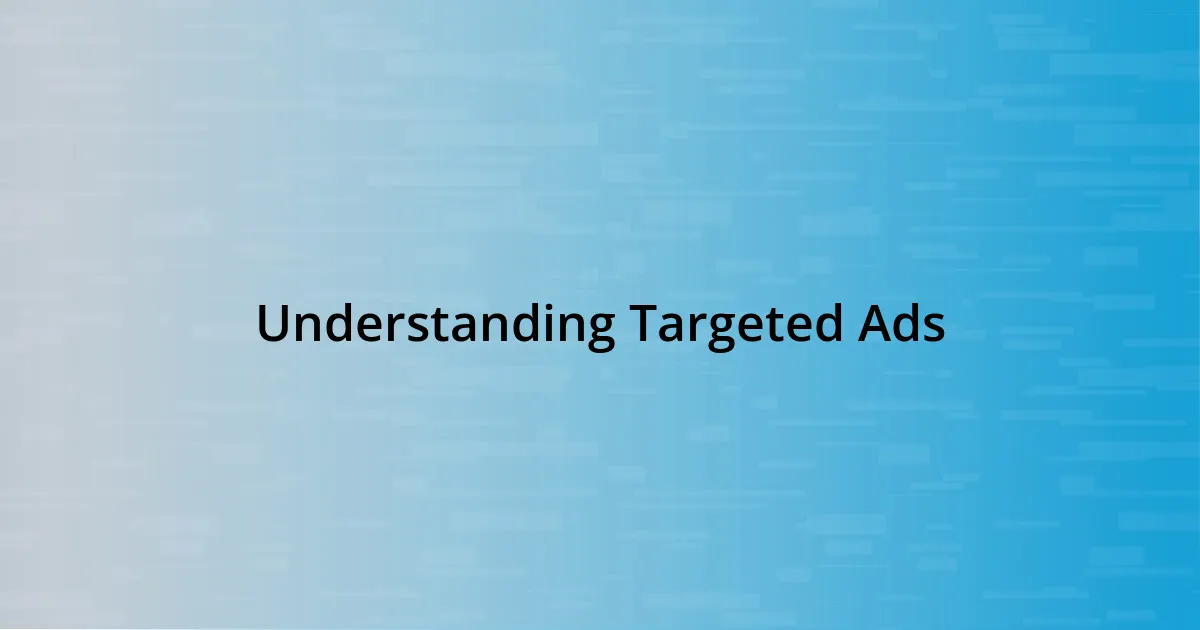
Understanding Targeted Ads
Targeted ads are designed to reach specific audiences based on their interests and online behavior, which is often a bit eerie, don’t you think? I remember scrolling through social media, and to my surprise, an ad popped up featuring a camera I had been idly viewing on an e-commerce site just days before. That moment made me wonder if my browsing habits were being meticulously tracked, revealing a world of advertising where personalization meets privacy concerns.
When I think about the mechanics behind targeted ads, it’s fascinating how algorithms analyze our data to predict what might catch our eye. It’s almost as if a digital version of me is out there, advocating for products I didn’t even know I wanted! But it’s not all sunshine; there’s a fine line between personalization and invasion. Have you ever found yourself feeling unsettled by an ad that seemed too personal? I have, and it makes me reflect on the balance between convenience and privacy that we navigate daily.
From my perspective, while targeted ads can be helpful, making me aware of the latest trends or sales, they can also lead to overwhelming information overload. I recall once receiving so many ads about home décor that I felt pressured to redecorate, even if I wasn’t initially interested. It’s a reminder that while these ads can enhance our shopping experience, they can just as easily create a sense of urgency and expectation that doesn’t align with our true needs.

My Journey with Targeted Advertising
As I reflect on my journey with targeted advertising, I can’t help but chuckle at the uncanny occurrences. For instance, I once mentioned a friend’s birthday present in passing, and shortly after, my feed was inundated with ads for gifts specifically tailored for girlfriends. That moment struck me as both impressive and a little surreal, making me question how closely my conversations were being monitored. It’s intriguing yet concerning how technology seems to interweave with our everyday discussions.
- I once browsed for hiking gear but didn’t end up buying anything.
- The following week, my social media was flooded with outdoor adventure ads.
- It felt like a gentle nudge, but also a reminder of how my interests were being tracked.
- I’ve also noticed that sometimes, when I search for an obscure book, the ads would surprise me with similar titles I’d never considered.
At times, I feel a sense of connection with these ads, as if they understand my interests. But, I also experience moments of discomfort, wondering to what extent my data is utilized. It’s that push and pull between convenience and privacy that constantly challenges my perspective on targeted advertising.

How I Encountered Targeted Ads
When I first started noticing targeted ads, it was like peering into a digital crystal ball that reflected my interests. There was one evening when I casually mentioned to a friend that I was hoping to learn how to bake sourdough bread. It wasn’t long after that my browser recommended everything from bread-making kits to specialty flours. Isn’t it wild how something as simple as a conversation can morph into a cascading wave of ads?
I also remember a peculiar experience while scrolling through my email one day. An ad for a travel agency popped up, showcasing a trip to a rainforest I had researched just hours earlier! It certainly made me question how tightly the online world intertwines with our lives. These moments leave me fascinated but slightly unnerved, as they illustrate the fine balance between useful suggestions and a feeling of being constantly watched.
To me, the way these ads tailor themselves to my interests is both a gift and a curse. I recently started exploring plant care, and soon enough, my Instagram was brimming with ads for rare succulents and online gardening courses. While I loved the tailored recommendations, it also felt stressful, as if an entire world of expectations had opened up around my new hobby. How do I navigate that pressure without feeling overwhelmed? I find myself asking this question often when faced with the avalanche of ads that seem to know me better than I know myself.
| Experience | Emotion |
|---|---|
| Sourdough baking kits appeared after casual mention to a friend | Amazed yet slightly violated |
| Travel agency ad after researching a rainforest trip | Intrigued but cautious of surveillance |
| Ads for rare succulents flooded my social media | Excited but overwhelmed by new expectations |
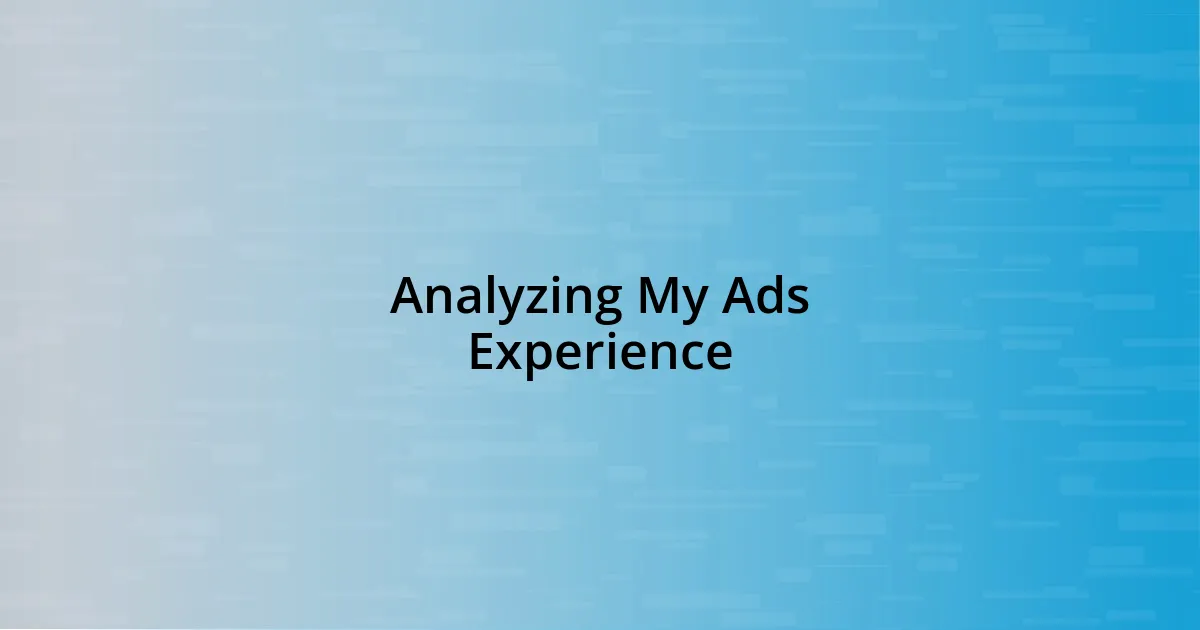
Analyzing My Ads Experience
I’ve had moments where the targeted ads felt like they were practically reading my mind. Take the time I casually scrolled through recipes online—right after, my feed was flooded with ads for cooking gadgets I didn’t even know I wanted. It wasn’t just amusing; it was a reminder of how connected everything is. But it made me wonder: am I really the one in control of my choices? Or am I simply dancing to the tune of the algorithm?
One striking example that stands out was my recent search for workout gear. Almost instantly, my social media platforms showcased a parade of athletic wear ads tailored to my preferences. Admittedly, I felt a jolt of excitement thinking, “Wow, this is just what I needed!” Yet, there was an undercurrent of discomfort—it felt too precise. It begs the question, does convenience come at the cost of my own privacy? I often find myself weighing the benefits against the implications of such keenly targeted content.
Then there was the time I dove into travel plans for an upcoming vacation. Initially, I made a few inquiries on flights and accommodations, and soon my entire browsing experience became inundated with travel deal ads. I felt a rush of gratitude, but also a hint of anxiety—how long will it be before the joy of exploring new places is overshadowed by the constant barrage of options? It’s a double-edged sword, really, feeling supported by helpful suggestions yet suffocated by the weight of endless choices.

Lessons Learned from Targeted Ads
One of the biggest lessons I’ve learned from my experiences with targeted ads is the power of intention behind my searches. I remember a day when I casually researched running shoes. Almost immediately, my social feed was awash with ads for the latest releases and exclusive discounts. While it was great to see options, it got me wondering: am I truly interested in the brands being advertised, or is my desire being manipulated by shiny promotions?
Another eye-opener was during a weekend binge of home improvement videos. Suddenly, my browser was crawling with ads for DIY tools and supplies. On one hand, the timing felt serendipitous, while on the other, it made me contemplate how easy it is for our interests to be monetized. I found myself asking, do these ads really enhance my life, or are they just nudging me towards products I might not need?
I’ve also noticed that targeted ads can create a cruel sense of urgency. I vividly recall spotting ads for a limited-time discount on a photography workshop just after I browsed some stunning photography portfolios. I felt a rush of excitement, but then a wave of panic: what if I miss this opportunity? It made me question my spending habits. Do I genuinely desire to grow my skills, or am I just responding to the marketing pressure? Each encounter with targeted ads has pushed my reflections deeper into the implications of consumerism and my own autonomy.

Tips for Navigating Targeted Ads
When it comes to navigating targeted ads, I’ve found that being aware of my online behavior can really make a difference. For instance, after I realized I was getting bombarded with ads for fitness equipment, I started to control my interactions online. Now, I consciously limit my browsing time and avoid clicking on ads that don’t spark genuine interest. This has helped me reclaim some autonomy in my online experience.
Another strategy that works for me is to diversify my online activities. I remember a time when I was deep into fashion blogs and suddenly, ads for every trendy item imaginable began flooding my feed. It felt overwhelming! To counter this, I’ve made it a habit to mix in different interests while browsing—whether it’s cooking, travel, or even tech news. This not only dilutes the ads bombarding me but also allows me to enjoy a broader range of content without a constant push towards specific purchases.
Lastly, I’ve learned to embrace the option of ad customization. There’s something empowering about taking control of the preferences that platforms use to tailor my experience. I vividly recall tweaking my settings on a popular social network and suddenly seeing ads that felt more aligned with my actual needs and interests. Have you ever tried adjusting your ad settings? It can feel like a small act of rebellion against the algorithm, reminding me that I can steer my experience, and it ultimately shapes the way I engage with brands and content around me.









